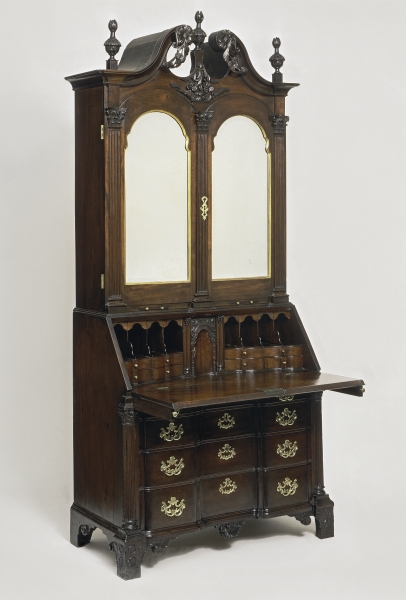· 9 ·
The Merchants’ Real Friend and Companion
GERALD W. R. WARD
In the moralistic print The Industrious Prentice (fig. 1), William Hogarth depicts the trusted apprentice Goodchild and his master Mr. West standing next to a highly stylized countinghouse desk and bookcase. Goodchild holds three items emblematic of his newly achieved position of trust: a sack of coins, a set of keys (presumably to the desk and bookcase or to the shop), and an open ledger labeled “Day Book.” One door of the bookcase is unlocked and open, revealing additional ledgers. The slant lid of the desk is also open, supported by lopers, and provides access to the small compartments inside. An inkwell with quill pen inserted rests on its surface, as do (somewhat oddly) two gloves that appear to be shaking hands, symbolizing a successful master–apprentice relationship. Two documents are pinned to the side of the case, one a London Almanack with a view of industry seizing time. West leans on Goodchild’s shoulder in a familiar manner, gesturing toward the looms (operated by women) that are the source of their prosperity. Hogarth’s interest was in telling a story, not depicting an eighteenth-century piece of furniture. Yet his morality play reminds us that the countinghouse desk, or, as here, desk and bookcase, was a significant element in a merchant’s life, the locus of the accounting and record keeping that allowed the merchant to maintain control of his business and monitor his economic status. With apologies to Robert Manwaring, the desk and bookcase was indeed a merchant’s real friend and companion.1
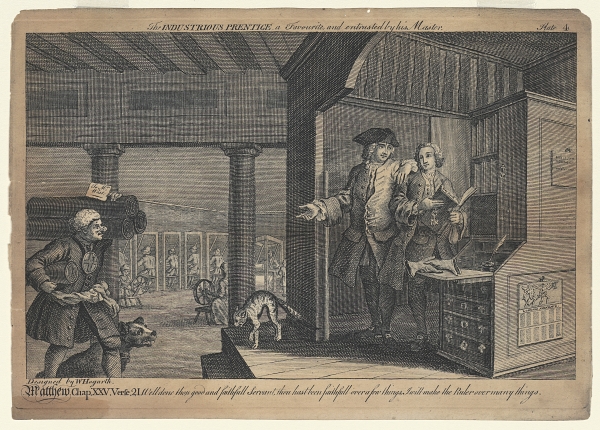
FIG. 1. The Industrious Prentice. a Favourite, and entrusted by his Master, William Hogarth (1697–1764), London, 1766–79. Line etching with some burin work; h 7⅞, w 11. Winterthur Museum; Bequest of Henry Francis du Pont (1969.1904).
The desk and desk and bookcase, its larger companion, are iconic forms of eighteenth-century American furniture. Boston was a center of commerce and learning in the eighteenth century, and high-style examples of these forms are landmarks of that era and area. Often of elaborate workmanship, on occasion beautifully carved, Boston desks and related furniture forms were made in substantial quantities by the best cabinetmakers. They were purchased and owned, as many documents and inventories tell us, by wealthy merchants, ministers, magistrates, and other notables. They abound, relatively speaking, in public and private collections, where they are admired for their stylishness and visual presence. Boston examples are often fitted with mirrored doors in the bookcase section, increasing their cost and enhancing their power as status symbols in the home. But Hogarth’s print reminds us that the form was also a core element of a merchant’s economic life, not only when located in the countinghouse but also when fashioned of well-selected walnut or mahogany and set within the house proper.2
Although the desk is the core of the form, the double-case type, with the desk surmounted by what is generally called a bookcase, is of particular interest here (fig. 2). The form was made throughout the Anglo-American world, and Boston examples are not unique.3 However, these objects were produced in significant quantities in the Boston area, and they reflect the import/export trade that characterized the town’s most prosperous years. They provide a manageable sample for placing the colonial use of this form on a timeline that charts the evolution of information processing; data storage, retrieval, and organization; and document protection and security.4
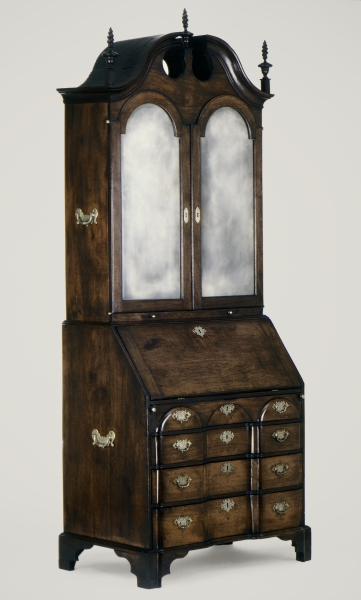
FIG. 2. Desk and bookcase, Job Coit Sr. (1692–1741) and Job Coit Jr. (1717–1745), Boston, 1738. Black walnut, white pine; h 100¼, w 39½, d 24½. Winterthur Museum; Museum purchase with funds provided by Henry Francis du Pont (1962.0087).
The Boston desks and desk and bookcases are particularly interesting not only as examples of the cabinetmaker’s and carver’s art but also from the viewpoint of social and economic history. In common with other case furniture, they are what the French philosopher Gaston Bachelard, in The Poetics of Space, calls the “houses of things”—the places, the boxes, in which we deposit, secrete, organize, store, and keep our smaller things. As the anthropologist Mary Douglas noted, dirt is just matter out of place, and furniture, especially case furniture, helps us keep our matter in place. Beginning with the Renaissance, people began to strive, and wish, for a new orientation to life, and that orientation brought a desire for an unprecedented degree of control over “stuff.” Our desks are reflections of, and key players in, that evolution.5
High-style desks were only part of the expression of the form. Less expensive and elaborate examples were made of maple, birch, and cedar, and the genre includes various types of countinghouse desks, such as the one depicted by Hogarth, including double-sided examples at which clerks could sit and write facing each other. Others were designed to be used by a merchant while standing; these sometimes had a baize-covered, sloped writing surface, with shelves for books and ledgers below.6
These utilitarian examples made from native woods have a few counterparts in a small group of Boston mahogany countinghouse desks whose form differs slightly from the customary slant-lid example. The group includes desks originally owned by the merchants John Amory and Peter Oliver that have slant lids that open upward to reveal an interior compartment, with a pull-out writing slide below. A third extraordinary example, clearly designed to be used while standing, was owned by Stephen Salisbury, a merchant from Boston and Worcester. The largest piece in this small group is the Hancock family desk (fig. 3), which displays a specialized configuration of cupboards and drawers built into the side of the case.7
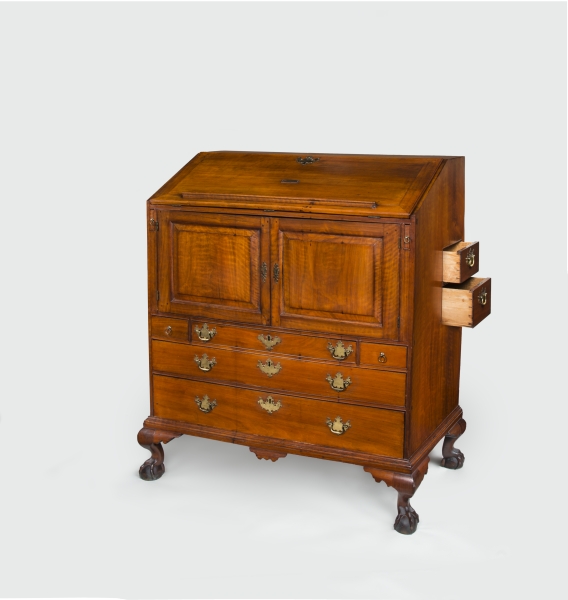
FIG. 3. Desk, Boston, 1750–70. Mahogany, white pine; h 56½, w 48, d 26. American Antiquarian Society. Photo, Gavin Ashworth.
These were, for the most part, working objects, despite their intrinsic aesthetic qualities. The labor they facilitated, as underscored by the group discussed in the previous paragraph, was specifically that of business and commerce. An eighteenth-century English or American gentlewoman might read with her elbow leaning on a table or while sitting in an upholstered armchair or easy chair, and an aristocratic gentleman of the period was often painted sitting at a writing table. The desks and desk and bookcases under consideration here were working tools as well as works of art, and they reveal much more about the business practices of prosperous tradesmen than about intensive or extensive patterns of reading.8
In particular, their use for stowing books, ledgers, business papers, correspondence, and small objects for writing speaks to the growing need to control the creation and storage of an increasing volume of such materials as the eighteenth century progressed. The intricate, architectonic, internal arrangement of drawers, pigeonholes, and sometimes ingeniously hidden secret compartments and intricate locking mechanisms is evidence of the daily work associated with accounting and epistolary practices. The organization and retrieval of the data recorded in letters and ledgers became increasingly complex and, literally, compartmentalized. This need for better business practices began in the late seventeenth century in Boston as a concomitant part of the evolution described in this volume by Edward S. Cooke Jr., as the “new Bostonians” began to participate more widely in the Atlantic world. Especially after the fire of 1711, Boston began to rebuild itself in a modern mode, with stylish Georgian houses taking the place of seventeenth-century gabled structures. The growing number of compartments in this furniture form bears witness to the increasing need for storing a variety of documents and can help us chart Boston’s economic development in broad terms.9
The interior of a typical early eighteenth-century Boston-area desk (fig. 4) has twenty separate compartments above and four drawers below, for a total of twenty-four units.10 That number is significant for this early date, and the number of compartments and subdivisions is of interest. It is exceeded by only a few rare American escritoires that are especially notable for the amount of such spaces they contain. The escritoire made by Edward Evans of Philadelphia and dated 1707, for instance, includes twenty-nine compartments, and the Brinckerhoff family example, made in New York a little later in the eighteenth century, has 40, including five secret ones. Recently, a third escritoire has surfaced, possibly made in Rhode Island for the Child family between about 1720 and 1730 (fig. 5). It has an astounding fifty-one compartments, including twenty-six “secret” spaces in the upper case, an extraordinary degree of articulation for this date. The forward-looking aspects of the escritoire may account for its rarity in American furniture; it provided a degree of specialization and compartmentalization that would not be routinely required for a few more decades. The form may have been produced in Boston (although no identifiable examples are known), but it was likely that English-made examples imported into the city provided local cabinetmakers with inspiration for the more complex arrangements of drawers, compartments, and secret spaces.11
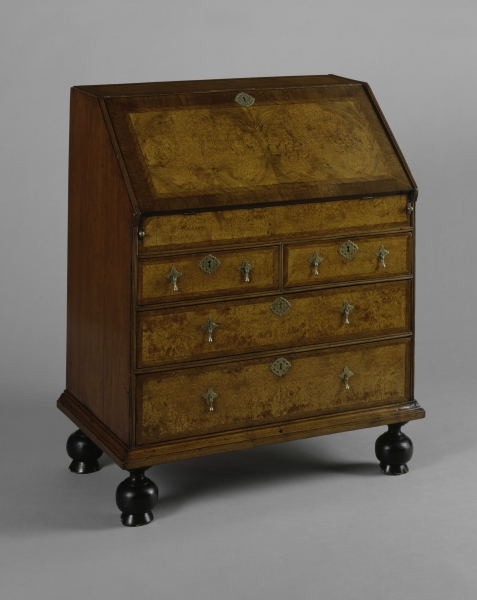
FIG. 4. Desk, Boston or vicinity, 1700–1730. Black walnut, ash, white pine, poplar; h 40, w 33¾, d 19. Metropolitan Museum of Art; Gift of Mrs. Russell Sage, 1909 (10.125.75).
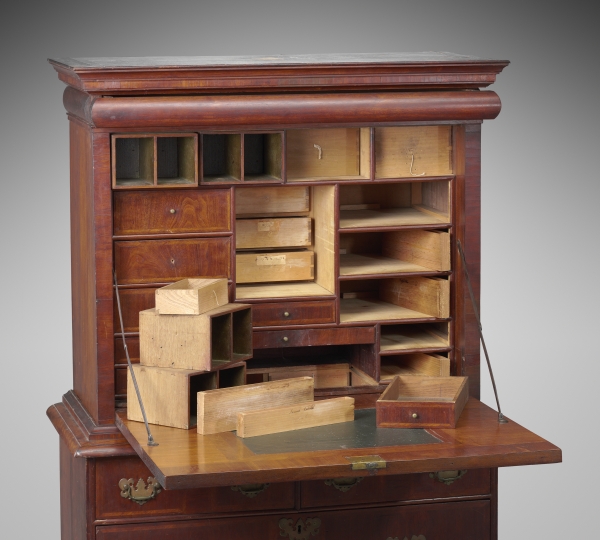
FIG. 5. Escritoire, possibly Warren, R.I., 1700–1730. Black walnut, walnut veneer, chestnut, white pine; h 66, w 39¾, d 18½. Museum of Fine Arts, Boston; Henry H. and Zoe Oliver Sherman Fund (2013.877).
A stylish desk and bookcase made in Boston perhaps as early as 1715 or 1720, probably for a member of the Avery family, is one of the early examples of the more typical form that would come to dominate the eighteenth century until after the Revolution (fig. 6). Like a few other examples of its time, it features walnut veneer and inlaid compass-work stars often seen on Boston furniture of this period. It is an aesthetic masterpiece.
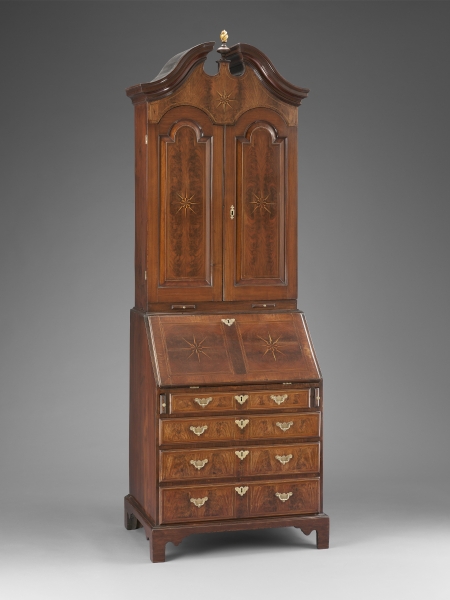
FIG. 6. Desk and bookcase, Boston, 1715–25. Black walnut, white pine, mahogany, rosewood, ebony, satinwood; h 88½, w 29⅝, d 20½. Museum of Fine Arts, Boston; The M. and M. Karolik Collection of Eighteenth-Century American Arts (39.176).
It also has the most amazingly well articulated and fully compartmentalized interior (fig. 7). In addition to the usual wide drawers in the lower case—a ubiquitous anachronism in this form—the desk section contains a beautiful stepped arrangement of small drawers and pigeonholes. The bookcase is also fully developed, with pigeonholes, spaces for ledgers, and other compartments. Unlike the Child escritoire, where the concerns of basic functionality and secrecy were paramount, the Avery desk and bookcase combines those attributes with an enhanced degree of stylishness. Its architectonic interior reminds us of a classical Roman theater, such as the second-century structure at Bosra, in which each space is clearly articulated in a rhythmic, curvilinear mode.12
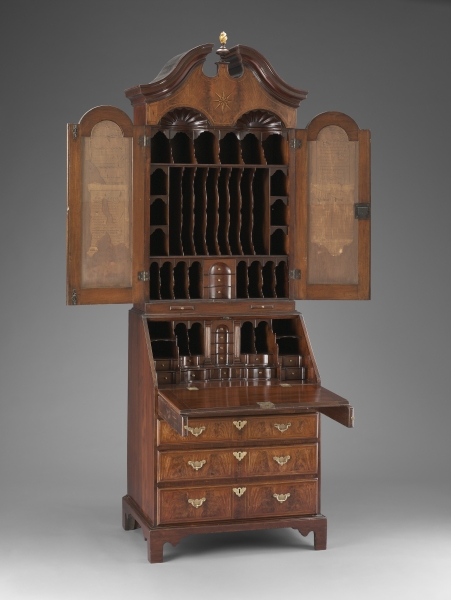
FIG. 7. Interior of the desk and bookcase in fig. 6.
The Avery desk and bookcase has an astounding sixty-one interior spaces, including five secret drawers. This number—exceeding that of the Child escritoire by about 20 percent—is a significant increase over seventeenth-century examples made only a generation or two before, which might have had only six or so separate spaces. This jump from single digits to fifty or sixty or more may not represent the equivalent of Moore’s law (which predicted, in the mid-1960s, that the amount of computing power will double every year, year and a half, or two years, a prediction that has been uncannily accurate for decades), but it does seem to signal a significant departure in this type of case furniture. In the Avery desk and bookcase and its peers, we see important objects that show a marked increase and improvement in document storage and organization, allowing for distinct areas that were easily accessible and labeled. The wide drawers in the lower case were probably used for the storage of various textiles, as with most examples of this form.
By the third quarter of the eighteenth century, the desk and bookcase form had crystallized and reached a high point in its evolution. George Bright’s bombé example (fig. 8), one of the most rococo objects made in Boston, has fifty-seven units, including fourteen pigeonholes, six slots for ledgers, three shelves, and six drawers in the upper case alone. Its interior spaces have the same vocabulary as other examples but a slightly different arrangement, and this degree of variation seems to be typical. The interiors of these desk and bookcases use more or less the same words, so to speak, but the sentences constructed with them are different. In this age of bespoke products, they reflect customization—whether the owner wanted more or less of this or that feature—depending on his profession. Some, for example, have more pigeonholes, perhaps reflecting an owner who had a high volume of correspondence, whereas others have more slots for ledgers, needed by a large business. As noted by Nancy Richards and Nancy Goyne Evans, Boston’s merchants were “economically poised to spend great sums on luxury items, [and] the very nature of their business demanded that they have fashionable furniture to house account books and provide a writing surface when open and proclaim their status when closed.”13
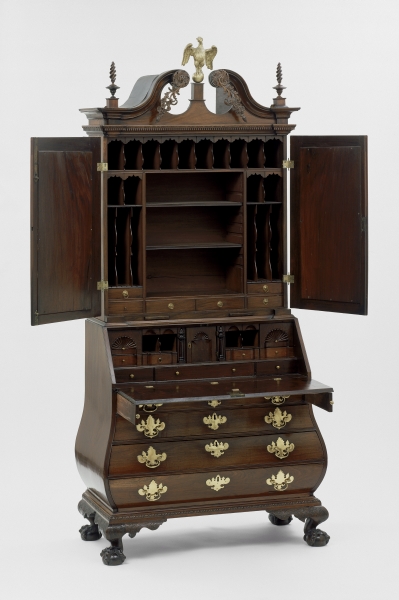
FIG. 8. Desk and bookcase, George Bright (1726–1805), Boston, 1770–85. Mahogany, white pine; h 99½, w 43, d 24. Museum of Fine Arts, Boston; Bequest of Miss Charlotte Hazen (56.1194).
What customers wanted and what cabinetmakers produced, then, is a machine for business, for commerce, and, perhaps occasionally, for reading pleasure and education. The desk section and the bookcase section meet a demand for control, organization, and purposefulness and give a sense of the piece as a tool for keeping track of one’s affairs in a manner that seems very modern. The desk and bookcase also conforms to the concept of “neatness” as defined in the eighteenth century, which encompassed concerns for orderliness, restrained elegance, cleanliness, respectability, and propriety. They demonstrate the rise of capitalism and entrepreneurship among the wealthiest members of society.14
What went into these compartments and how were they used? First, they may have served as memory palaces—a way to help people remember where they put things, as in the old saw “a place for everything, and everything in its place.” The items to be remembered in this mnemonic system are mentally associated with specific physical locations, and thus are more easily recovered. Placing the correspondence with a particular individual or firm in a given pigeonhole would help the user retrieve it quickly and efficiently.15
The tall, thin, vertical compartments were often reserved for ledgers of various types. Daniel Defoe’s Compleat English Tradesman (1726–27) offered much advice about the importance of account books for businessmen. He recommended four kinds:
- 1. A Cash-book for entry of all money paid and receiv’d in his way of trade.
- 2. A Petty-cash book, to enter small expences into, and what you may think not worth troubling your great Cash-book with.
- 3. A Day-book or Journal, wherein to enter everything taken in, or delivered out.
- 4. A Blotting-book, or preserver of the memory for the other to be recopy’d after the shop or warehouse is shut, and the trade and hurry of the day is over.16
American merchants, like Thomas Hancock and his nephew John Hancock (fig. 9), often used single-entry or sometimes double-entry bookkeeping, invented by the merchants of Venice in the fifteenth century. In this way did they keep track of a far-flung, often confusing, and slow-moving business, carefully recording the incoming and outgoing transactions that might take weeks, months, or even years to move from start to finish.17
These ledgers and account books came in different sizes, some quite large. Richard Fry, “Stationer, Bookseller, Paper-maker, and Rag Merchant” recently arrived from London, advertised in the Boston Gazette in May 1732 that he sold “sets of Accompt-Books, after the neatest manner” in his shop at Mr. Thomas Fleet’s printing enterprise at the Heart and Crown in Cornhill. Fry went on to claim that, “whereas, it has been the common Method of the most curious merchants in Boston, to Procure their Books from London,” he “will sell all Sorts of Accompt-Books, done after the most acute Manner, for 20 per cent. cheaper than they can have them from London.” (A typical thrifty approach aimed at Bostonians; some things never change.)18
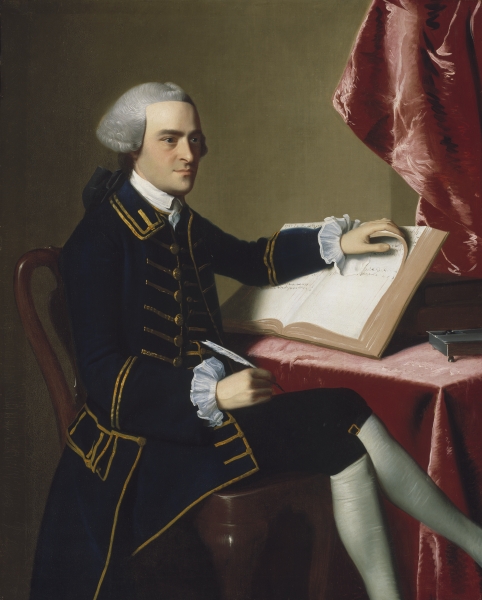
FIG. 9. John Hancock, John Singleton Copley (1738–1815), Boston, 1765. Oil on canvas; h 49, w 39⅜. Museum of Fine Arts, Boston; Deposited by the City of Boston (L-R 30.76d).
So, in many cases, those tall thin compartments were for the ledgers—journals, cash books, and so on—that merchants well into the nineteenth century kept close at hand for daily review. The largest volumes might have been stored flat on a shelf. Among the survivors are about nine journals and receipt books covering the years 1755 to the 1790s that were used by the Hancock family; about eleven similar journals and ledgers of the Henchman family survive for the period 1718–50. Even allowing for the addition of letter-books (five in the case of the Hancocks) and lost volumes, a standard desk and bookcase could have accommodated a family’s paperwork or provided adequate storage for a colonial merchant’s activities for three or four decades.19 The pace of business life, in terms of accounts or daily correspondence, has been reckoned as less than hectic by modern standards, albeit plagued by uncertainty, slow communications, and the constant need for calculated decision-making. One can easily imagine almost any eighteenth-century American merchant using a single desk and bookcase as the epicenter of his enterprise.20
In most cases, the small drawers held quills, inkstands, papers, ribbons, and other writing accoutrements. John Perkins of Boston, in his shop on Union Street, sold this sort of material imported from London, including five types of paper, Spanish pocket books, ivory memorandum pocket books, various types of eyeglasses, ink and ink powder, Dutch quills, sealing wax and wafers, slates and slate pencils, inkpots and inkstands, and other stationery goods.21 In addition to accounting and basic arithmetical skills, merchants (and their clerks) also needed good penmanship, a fact underscored by the fine examples pasted inside the doors of the Avery desk and bookcase (see fig. 7). These samples include several odes to Liberty and Commerce, as well as “The Penman’s Advice,” all derived from The Universal Penman (1743) engraved by George Bickham, as well as a stanza taken from Paul Revere’s print View of the Obelisk of 1766.22 The transcriptions are signed and dated that year by Benjamin Gudworth and Thomas Blake, whose identities are undetermined; perhaps they were young, patriotic clerks in the employ of a merchant.
As noted earlier, the pigeonholes (as they were called) were perfect for letters, which in this period were typically folded, bundled, and tied with a ribbon, often red. The pigeonholes in an English or Irish example of the mid-1740s, now at Temple Newsam, “have Labels of the Alphabet over them,” as recommended by Thomas Chippendale. This practice represents the beginnings of a filing system that would persist for years—one that allowed merchants and others to cope with an increasing volume of correspondence and paperwork.23
Some individuals used the form in idiosyncratic, individualistic ways. Samuel Edwards (1705–1762), the Boston silversmith and merchant, had a desk and bookcase in his shop when he died in 1762. It contained materials related to his craft and merchant activities—sleeve buttons, parts for buckles, a set of weights, rowels (spiked revolving disks) for spurs, small tools and instruments—and was very much a work station, perhaps like the one depicted in Hogarth’s Industrious ’Prentice (see fig. 1).24
The small drawers and pigeonholes also addressed the need for privacy and security between family members, family members and servants, and the family and the outside world. Many desks and desk and bookcases had secret compartments, each constructed in a slightly different manner. In some cases, a couple keys were required to reach the innermost compartments, and only thorough knowledge of the object could make it reveal all its secrets. Possession of the keys, and the knowledge of how to use them, was an important responsibility. Who to entrust with this duty was an important question for each household to answer.
To fully plumb a representative example, such as the Quincy family desk and bookcase (fig. 10), can take six or seven steps—after the interloper has broken into the house, that is. First, you must unlock the slant lid with a key. Next, a smaller key unlocks the interior prospect door that covers a compartment with a small drawer at the bottom and a shelf above. Once that door was open, you have to remove the drawer in the center compartment and then press on a little wooden strip (or spring lock), releasing the compartment. That entire compartment can then be pulled out (fig. 11) The back of the compartment is covered by a panel (as seen in fig. 12), which then needs to be lifted up to reveal the back of a pine box containing four small shallow drawers once fitted with leather pulls nailed in place. Once you have extricated that box, you gain access to two tall, thin, so-called document drawers buried even deeper inside (fig. 13). (In case of fire, an owner well acquainted with the process might be able to quickly remove the prospect-drawer section and save important papers and money.) In some other examples, additional secret drawers can be accessed by reaching into the open cavity inside the desk, where three little lidded boxes were housed in a channel that runs from side to side. The middle box must be removed first to allow access to those at each side.25 These “secret” drawers and little boxes were probably where owners kept precious objects, including jewelry and coins.26 The interior of a “Scrutore” owned by George Rogers in Suffolk County, Massachusetts, contained at his death in 1748 substantial amounts of paper money and silver coins, along with rings, a necklace, lockets, shoe buckles, and other costly small objects.27
FIG. 10. Desk and bookcase, Boston, 1740–50. Mahogany, sabicu, eastern red cedar, ash, white pine; h 97¼, w 42⅞, d 23½. Winterthur Museum; Gift of Henry Francis du Pont (1960.1134). According to tradition, Josiah Quincy (1704–1784) of Braintree acquired this object second-hand in 1778, and it descended in his family. For another detail of this object, see fig. 18.
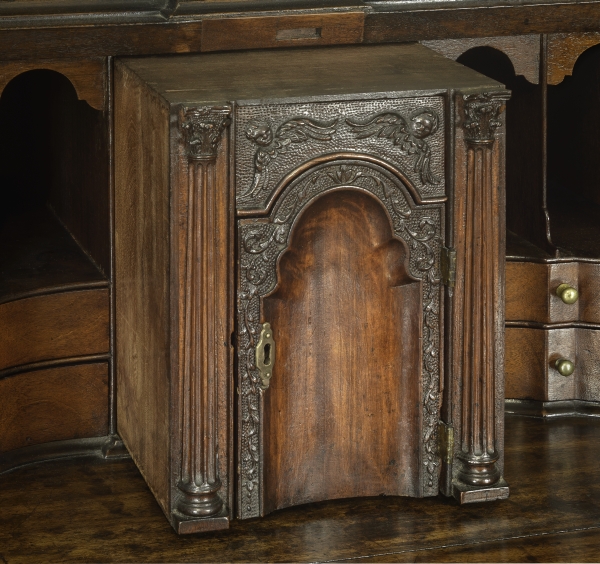
FIG. 11. Detail of the desk and bookcase in fig. 10, with the prospect section pulled forward after the release of a spring lock.
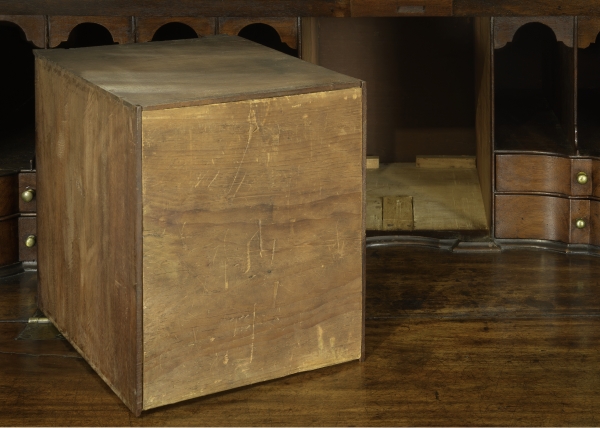
FIG. 12. Detail of the desk and bookcase in fig. 10, showing the back of the prospect section covered with a plain panel; the spring lock is visible in the background, on the floor of the prospect-door compartment.
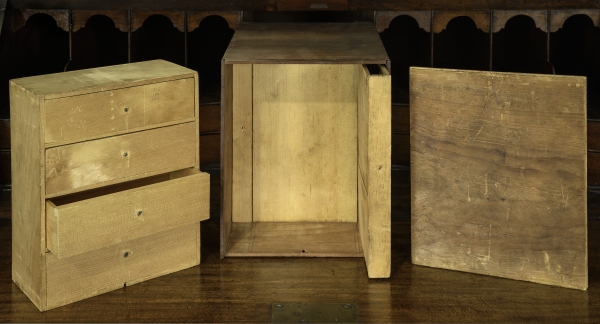
FIG. 13. Detail of the desk and bookcase in fig. 10, with the back panel of the prospect section (seen at right) removed, revealing the tier of four small horizontal drawers and one of the two tall, thin document drawers housed within.
The somewhat complicated process of unlocking and peeling away various desk drawers is not necessarily difficult, but as with computer passwords today, the series of steps helped slow down or discourage a potential thief. These desks and desk and bookcases were owned primarily by well-to-do people, and not everyone was familiar with the process for accessing their contents.28 Thus, they speak to issues of class and privacy. Their built-in safeguards must have failed in many instances, however, releasing the owner’s treasures to determined thieves. When an angry mob ransacked the Boston house of Thomas Hutchinson in 1765, as recounted by John Tyler in this volume, Hutchinson’s sons Thomas and Elisha each owned a walnut desk and lost “money in his desk of which he is certain,” totaling £146.18.9 and £110, respectively.29
The question of the security of one’s papers in colonial Massachusetts was not an idle one. The invasion of private homes in illegal searches for papers was an important issue in the third quarter of the eighteenth century in particular, fueled by the controversy over the search-and-seizure case involving John Wilkes, the charismatic Englishman who was a hero to many Bostonians on an almost mythical level. His name and his pamphlet no. 45 were referenced, for example, on Paul Revere’s Sons of Liberty bowl, fashioned in 1768. Wilkes was imprisoned after government agents broke into his home, armed with sweeping warrants that were later deemed illegal, on a hunt for papers that would prove he was the author of anti-government essays published anonymously. The writs of assistance case of 1761 in Massachusetts, in which James Otis challenged the legality of statutes allowing broad search powers to customs officials, also figured into the Boston concern for protecting people’s houses, persons, and papers, even when these were stored secretly in objects such as desk and bookcases. This continuing concern was reinforced in the Massachusetts Constitution of 1780, in article XIV, which guaranteed that “every subject has a right to be secure from all unreasonable searches and seizures of his person, his houses, his papers, and all his possessions” (emphasis added), a right reiterated in the fourth amendment to the United States Constitution.30
• • •
In the seventeenth century in North America, case pieces often had a single, large, undifferentiated interior space, with perhaps a small till inside. (Exceptions can be found in some rare small boxes and cabinets for jewelry, which form a separate category.) It was the one place over which a person could exert control and that served as a safe resting place for worldly belongings, things that imparted a sense of personal identity. It was the one place he or she could protect, survey, and rearrange. There might also be a drawer or two or three below, as with (for example) a Hadley chest of about 1700 that is embellished with the name of its owner, Mary Pease, underscoring the correlation between the person and the object. Some extraordinary pieces, like a Boston chest of drawers with doors of the 1650 to 1670 period, now at Yale University, might have six spaces, but that is about the maximum for this early period in Boston in terms of large case furniture.31
These seventeenth-century objects sit at what Stephen Jay Gould would describe as the left, or minimal, wall in any chart plotting the degree of complexity over time. At the beginning of our timeline, forms are simpler and become increasingly complicated as we advance in time. In nature, Gould’s area of interest, we move from bacteria to algae to jelly fish to fish, dinosaurs, saber-toothed tigers, and Homo sapiens (noting that bacteria stays with us all the way). Yet, according to Gould, life forms show no true progress. The so-called progress, or developing complexity, from bacteria to Homo sapiens, is “really random motion away from simple beginnings, not directed impetus toward inherently advantageous complexity.”32 (So much for us.)
Can furniture forms, as a product of the human mind, evolve toward inherently advantageous complexity? Furniture is not subject to natural selection, a mechanism that yields only local adaptation to changing environments, not general progress. But it is responsive to the ideas of people about how to organize and structure their surroundings (presumably) for the better. Progress may be possible, if our ideas are improving. Change, however, is inevitable.
What was Boston’s place in the mid-eighteenth century on a hypothetical curve away from minimal complexity? The jump from single digits of compartments to fifty or more suggests that the city had moved forward but was still far behind other countries and civilizations. One example that demonstrates how much it lagged is an extraordinary escritoire made in Oaxaca, Mexico, about 1671, notable for its incredible marquetry (fig. 14). It is also significant at this early date for its interior, which holds seventeen compartments (made to look like twenty-one). Used by high-ranking Spanish colonial officials or made for export to Spain, this desk follows European prototypes, but even it is overshadowed by more sophisticated and complex continental examples made a century earlier.33
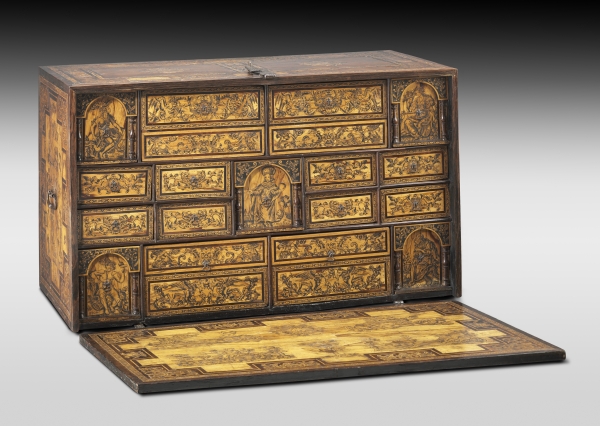
FIG. 14. Escritorio, Oaxaca, Mexico, ca. 1671. Linaloe, granadillo, cedar, marquetry, and filled engraving; h 243/16, w 415/16, d 17¾. Museum of Fine Arts, Boston; Museum purchase with funds donated anonymously, William Francis Warden Fund, American Decorative Arts Deaccession Fund, Arthur Tracy Cabot Fund, Edwin E. Jack Fund, and by exchange from a Gift of Harold Whitworth Pierce, Gift of Miss Ellen Graves, Mr. Samuel Cabot and Mrs. Roger Ernst in memory of their father and mother, Mr. and Mrs. Edmund P. Graves, Gift of Mary W. Bartol, John W. Bartol, and Abigail W. Clark, William E. Nickerson Fund, Gift of Mrs. Henry Lyman, Bequest of Barbara Boylston Bean, Charles Amos Cummings Fund, Gift of Mrs. Charles L. Bybee, Bequest of Dudley Leavitt Pickman, Gift of Henry G. E. Payson, and from funds donated by Mrs. Walter Hunnewell in memory of Walter Hunnewell (2010.370).
So, the Massachusetts Bay colonists were not necessarily in the forefront, at least in this regard. But Boston desks and desk and bookcases, by the period from roughly 1725 to 1775, stand at a critical point in the trajectory of document storage and retrieval, representing the transition from an era of minimal complexity toward more recognizably modern degrees of specialization and organization. By the time of the Avery desk and bookcase (see figs. 6–7), we have reached a point—and rather quickly, really—that is (or was) recognizably modern. The historian John Demos has theorized that a mid-eighteenth-century desk and bookcase would have baffled a seventeenth-century person unfamiliar with its complexity and compartmentalization.34 A Georgian house, with its specialized rooms for dining and other activities, would have struck that person as being worlds apart from their multifunctional domestic interiors, wherein the hall was used for eating, sleeping, and cooking, all in one space.
The desk and desk and bookcase forms persisted and were effective for more than two centuries. That is one aspect of the desk and bookcase form of about 1750 that makes it a key landmark in American furniture history. The Wooten desk, popular 150 years later, in the 1870s and early 1880s, was really just a refinement and extension of the Avery desk. Only in our lifetimes, and only with the advent of the personal computer around 1980, did the game change dramatically as we’ve moved from rows of filing cabinets to desktops to laptops with enormous memory and the ability (in theory) to hold and organize one’s entire life. Smartphones and flash drives seem to have almost infinite capacity, without all the mahogany and white pine needed to cradle documents and accounts that now can be settled on the Internet. Something has been gained, but something is lost as well.
Nevertheless, we may always need places for papers and objects that are important to us. Kim Schmahmann’s Bureau of Bureaucracy (1993–99) reminds us of this fact (fig. 15). He designed this cabinet to hold documents relating to his life—the precious objects of today, in his view. There is even a drawer in the lower case awaiting his death certificate.
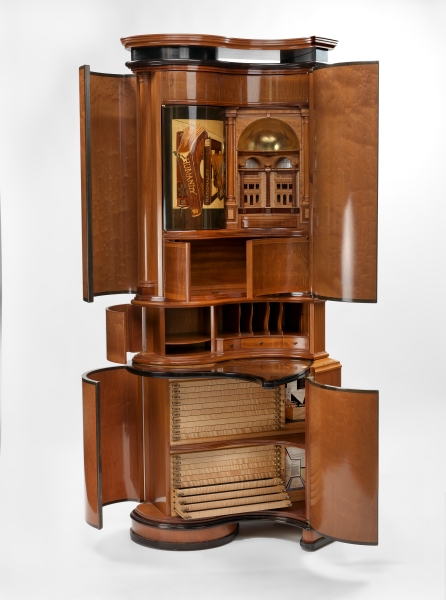
FIG. 15. Bureau of Bureaucracy, Kim Schmahmann (b. 1955), Cambridge, Mass., 1993–99. Various hardwoods, veneers, marquetry, mother of pearl, gold leaf, brass; h 96, w 36, d 24. Smithsonian American Art Museums; Gift of an anonymous donor (2000.48A-H).
Schmahmann’s piece brings the circle to a close. In a way, its purpose harkens back to the simplest of forms—a seventeenth-century chest designed to hold one’s most treasured possessions, to be an encapsulation of the self. But in echoing an eighteenth-century form (or, more precisely, a Biedermeier form of the early nineteenth century), Kim’s elaborate, highly specialized bureau does the same thing: it embraces and encloses the things that represent his very personhood. It is a reminder that all objects are important for many reasons, not the least of which is the light they shed on the human condition in the past as well as the present.

1. E. McSherry Fowble, Two Centuries of Prints in America, 1680–1880: A Selective Catalogue of the Winterthur Museum Collection (Charlottesville: University Press of Virginia for the Henry Francis du Pont Winterthur Museum, 1987), cat. no. 176; and Sean Shesgreen, ed., Engravings by Hogarth: 101 Prints (New York: Dover, 1973), no. 63. Robert Manwaring, The Cabinet and Chair Makers’ Real Friend and Companion, or the Whole System of Chair-Making Made Plain and Easy (London, 1765).
2. This essay is based on my interest in the functionality of case furniture explored in “Matter in Place: Some Thoughts on Case Furniture,” in Gerald W. R. Ward, American Case Furniture in the Mabel Brady Garvan and Other Collections at Yale University (New Haven: Yale University Art Gallery, 1988), 3–17. These thoughts were later presented at the Colonial Williamsburg Forum and to the American Furniture Collectors Society of the Western Reserve in Ohio. I am grateful to many individuals for their comments and assistance, particularly Barbara McLean Ward.
3. The nomenclature for such forms is various and often difficult to decipher. For an overview of the form, which in English is generally referred to as a bureau, see Ralph Edwards, The Shorter Dictionary of English Furniture (London: Country Life, 1964), 72–109, esp. the entries on bureaux and cabinets. Boston examples, stylistically, are most indebted to English prototypes; see Adam Bowett, Early Georgian Furniture, 1715–1740 (Woodbridge, Eng.: Antique Collectors’ Club, 2009), chap. 2.
4. For a quick overview of the desk form and its many variants, see Mark Bridge, The Encyclopedia of Desks (London: Apple Press, 1988). A helpful study of one American regional variant is Sumpter Priddy, “Musings on a Scottish-Irish Desk Form in Colonial Virginia: The Scrutoire,” in the MESDA online journal for 2012, accessed May 22, 2014, from http://www.mesdajournal.org/2012/musings-sottish-irish-desk-form-colonial-virginia-scrutoire. A lyrical discussion of the importance of a desk from a woman’s perspective is in Susan M. Stabile, Memory’s Daughters: The Material Culture of Remembrance in Eighteenth-Century America (Ithaca, N.Y.: Cornell University Press, 2014), chap. 2.
5. Gaston Bachelard, The Poetics of Space (Boston: Beacon Press, 1994), chap. 3, and Mary Douglas, Purity and Danger: An Analysis of Concepts of Pollution and Taboo (New York: Praeger, 1966), 35.
6. See, for example, the portrait of the Connecticut dry-goods merchant Elijah Boardman painted by Ralph Earl (1751–1801) in 1789 (Metropolitan Museum of Art, 1979.395).
7. For these variants on the merchant desk, see Edwin J. Hipkiss, Eighteenth-Century American Arts: The M. and M. Karolik Collection (Cambridge: Harvard University Press for the Museum of Fine Arts, Boston, 1941), cat. no. 26, acc. no. 39.85 (Amory family); Gerald W. R. Ward, The Cabinetmaker and the Carver: Boston Furniture from Private Collections (Boston: Massachusetts Historical Society, 2013), cat. no. 18 (Salisbury example now in a private collection); and Wendell D. Garrett, “Furniture in the American Antiquarian Society,” Antiques 97, no. 3 (Mar. 1970): 404, figs. 4–4a (Hancock family). The example owned by Peter Oliver is now in a private collection.
8. For a general survey, see Leonée Ormond, Writing (London: Her Majesty’s Stationery Office, 1981), esp. 38.
9. See also Phyllis Whitman Hunter, Purchasing Identity in the Atlantic World: Massachusetts Merchants, 1670–1780 (Ithaca, N.Y.: Cornell University Press, 2001), chap. 3.
10. Frances Gruber Safford, American Furniture in the Metropolitan Museum of Art, vol. 1, Early Colonial Period: The Seventeenth-Century and William and Mary Styles (New York: Metropolitan Museum of Art, 2007), cat. no. 133. For another example of this form, thought to have been owned by the minister Jonathan Edwards (1703–1758), who added separate wings and a superstructure to hold his expansive library, see Ward, American Case Furniture, cat. no. 172.
11. The Evans example is in the Colonial Williamsburg online database (acc. no. 1958–468); the extraordinary Brinckerhoff family example is illustrated in Jerry E. Patterson, The City of New York: A History Illustrated from the Collections of the Museum of the City of New York (New York: Harry N. Abrams, 1978) 33. The author is grateful to Dennis Carr and Peter Kenny for their assistance in understanding this early form. The account book of Jacob Wendell (Massachusetts Historical Society) includes an invoice for two cases shipped from London by Wendell on March 21, 1715, to Daniel Russell in Boston. The two cases contained “One new fashiond Scutore” valued at £6.19. My thanks to Brock Jobe for supplying this reference.
12. The Bosra theater is a UNESCO World Heritage site; many images are available on the Internet.
13. Nancy E. Richards and Nancy Goyne Evans, with Wendy A. Cooper and Michael Podmaniczky, New England Furniture at Winterthur: Queen Anne and Chippendale Periods (Winterthur, Del.: Henry Francis du Pont Winterthur Museum, 1997), 435.
14. Amanda Vickery, Behind Closed Doors: At Home in Georgian England (New Haven: Yale University Press, 2009), esp. 20, 180–82.
15. A Salem gentleman’s secretary from a later generation now in the Museum of Fine Arts, Boston, was owned originally by Capt. Clifford Crowninshield and, later, his son-in-law James Devereaux, who inscribed its pigeonholes with the names of his ships; see Richard H. Randall Jr., American Furniture in the Museum of Fine Arts, Boston (Boston: Museum of Fine Arts, Boston, 1965), cat. no. 67.
16. Daniel Defoe, The Complete English Tradesman in Familiar Letters, Directing Him in All the Several Parts and Progressions of Trade, 2 vols. (reprint, New York: Augustus M. Kelley, 1969), 1:43. Memory palaces (ars memorativa), it is thought, were invented by the Greek poet Simonides of Ceos some 2,500 years ago; for an informal history of the concept, see Joshua Foer, Moonwalking with Einstein: The Art and Science of Remembering Everything (New York: Penguin Press, 2011). Ledgers and books, which replace and supplement human memory, need their own storage system for efficient retrieval, an aid provided by the desk and bookcase. For early attempts at organizing materials, see Ann M. Blair, Too Much to Know: Managing Scholarly Information before the Modern Age (New Haven: Yale University Press, 2010).
17. For an overview of bookkeeping methods, see Jane Gleeson-White, Double Entry: How the Merchants of Venice Created Modern Finance (New York: W. W. Norton, 2011). For the complex operations of one significant family, see W. T. Baxter, The House of Hancock: Business in Boston, 1724–1775 (Cambridge: Harvard University Press, 1945).
18. Reprinted in George Francis Dow, comp., The Arts and Crafts in New England, 1704–1775 (Topsfield, Mass.: Wayside Press, 1927), 277.
19. Numbers of surviving account and letter books are provided in Baxter, House of Hancock, 35, 63.
20. For a fascinating reconstruction and quantification of a colonial merchant’s daily activities, see Arthur H. Cole, “The Tempo of Mercantile Life in Early America,” Business History Review 33, no. 3 (Autumn 1959): 277–99. See also Natasha Glaisyer, The Culture of Commerce in England, 1660–1720 (Woodbridge, Eng., and Rochester, N.Y.: Royal Historical Society/ Boydell Press, 2006), esp. chap. 3 for a comparative perspective.
21. Boston Gazette, June 13, 1763, reprinted in Dow, Arts and Crafts, 282–83.
22. The Universal Penman, Engraved by George Bickham (London, 1743; reprint, New York: Dover, 1954), 29, 109, 115, 117, 119. Clarence S. Brigham, Paul Revere’s Engravings (New York: Athenaeum, 1969), 26–31.
23. Christopher Gilbert, Furniture at Temple Newsam House and Lotherton Hall: A Catalogue of the Leeds Collection, 2 vols. (Leeds, England: National Art-Collections Fund and Leeds Art Collections Fund, 1978), 1:42–44, cat. no. 29. Thomas Chippendale, The Gentleman and Cabinet-Maker’s Director, 3d ed. (1762; reprint, New York: Dover, 1966), 10, caption for pl. 75. For an extraordinary modern version of this practice, see an escritorio (alphabet writing desk) made in Boston in 2008 by Miguel Gómez-Ibáñez, with painted letters and botanical scenes by Joseph W. Reed, which is illustrated in Jeffrey Brown and Pat Warner, with the assistance of Michael McMillan and with essays by Jonathan L. Fairbanks and Gerald W. R. Ward, Made in Massachusetts: Studio Furniture of the Bay State (Brockton: Fuller Craft Museum, 2013), 48–49.
24. See the entry on Edwards by Barbara McLean Ward in Colonial Massachusetts Silversmiths and Jewelers, ed. Patricia E. Kane et al. (New Haven: Yale University Art Gallery 1998), 437–54; the inventory listing for the desk and bookcase is transcribed on 443.
25. This additional refinement is present on the George Bright desk and bookcase (56.1194) and a Boston desk (39.87) in the MFA collection.
26. In a broadside dated May 23, 1793, of the household furniture to be sold at auction and belonging to Madame Fitzpatrick, residing in what is now the Shirley-Eustis House in Roxbury, the listing for item 100 is an “Elegant and curious writing Desk with Drawers, Secrets, &c.” (emphasis added); see Bdses 1793 May 23, Massachusetts Historical Society, Boston, Mass.
27. Cited in Brock Jobe and Myrna Kaye, with the assistance of Philip Zea, New England Furniture, the Colonial Era: Selections from the Society for the Preservation of New England Antiquities (Boston: Houghton Mifflin, 1984), 227–29. Secret compartments in furniture remain a concern; see, for example, Travis Larson, “20 Secret Hiding Places: Clever Ways to Hide Your Valuables,” Family Handyman (Feb. 2014): 44–48.
28. In the 1980s, Robert Mussey and Barbara McLean Ward discovered previously undetected secret compartments in the upper case of Rhode Island desk and bookcases in the Rhode Island School of Design and Winterthur collections. The compartment in the Winterthur example held a cache of hundreds of eighteenth-century sewing needles.
29. Locks in early American furniture remain a largely unexplored topic. For a monograph on the more sophisticated mechanisms in French furniture, see Carolyn Sargentsen, “Looking at Furniture Inside-Out: Strategies of Secrecy and Security in Eighteenth-Century French Furniture,” in Furnishing the Eighteenth Century: What Furniture Can Tell Us about the European and American Past, ed. Dena Goodman and Kathryn Norberg (New York: Routledge, 2007), 205–36. See also Sigfried Giedion, Mechanization Takes Command: A Contribution to Anonymous History (1948; reprint, New York: W. W. Norton, 1969), 51–76.
30. These issues are discussed in laymen’s terms in Akhil Reed Amar, The Law of the Land: A Grand Tour of Our Constitutional Republic (New York: Basic Books, 2015), 229–42. See also Arthur H. Cash, John Wilkes: The Scandalous Father of Civil Liberty (New Haven: Yale University Press, 2000), esp. chap. 5, and many passages in David H. Flaherty, Privacy in Colonial New England (Charlottesville: University Press of Virginia, 1972).
31. See the editor’s introduction in Barbara McLean Ward, ed., A Place for Everything: Chests and Boxes in Early Colonial America (Winterthur, Del.: The Henry Francis du Pont Winterthur Museum, 1986), 5–6.
32. See Stephen Jay Gould, Full House: The Spread of Excellence from Plato to Darwin (New York: Harmony Books, 1986), 171, fig. 29.
33. A famous sixteenth-century Schreibtisch (writing cabinet) from Augsburg demonstrates Europe’s lead, at the highest levels; see Georg Himmelheber, Der Maitländer Kabinettschrank, ein Augsburger Prunkmöbel des Manierismus (Vienna: Liechtenstein Museum, 2010).
34. “Giving an Elephant to Blind Men? The Cross-Disciplinary Role of a Desk and Bookcase,” Arts Magazine 59, no. 2 (Oct. 1984): 87–99.

